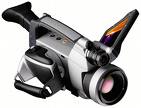|
 Thermal cameras: Thermal cameras:
Thermal cameras (also known as infrared imagers) are detector and lens combinations that give a visual representation of infrared energy emitted by objects. Thermal infrared images let you see heat and how it is distributed. A thermal infrared camera detects infrared energy and converts it into an electronic signal, which is then processed to produce a thermal image and perform temperature calculations. Thermal imaging cameras have lenses, just like visible light cameras. But in this case the lens focuses waves from infrared energy onto an infrared sensor array. Thousands of sensors on the array convert the infrared energy into electrical signals, which are then converted into an image.
Infrared is a type of light that we cannot see with our eyes and brings us special information that we do not get from visible light. It shows us how much heat something has and gives us information about an object's temperature. See Infrared Light for more information.
On famous astronomical thermal camera is the IRAC camera, which resides on the Spitzer Space Telescope (SIRTF), a cryogenically cooled IR telescope and the last of the Great Observatories.
Additional Links:
|





